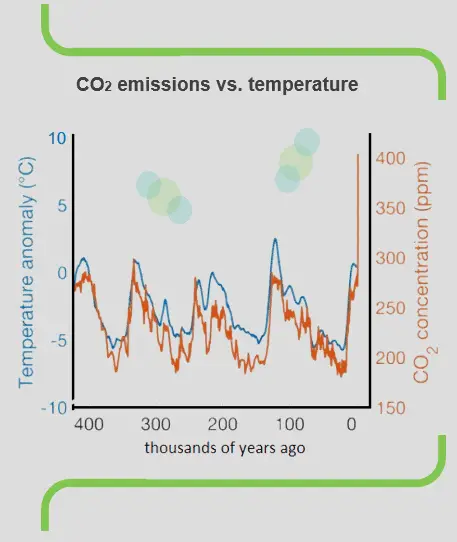Why do the majority of fossil fuels need to stay underground?
Arctic sea ice is now declining at a rate of 13% per decade.
 Climate change is the most important environmental challenge facing our world today. Arctic sea ice is now declining at a rate of 13% per decade, relative to the 1981 to 2010 average. The release of greenhouse gases (GHGs) into the atmosphere at ever-increasing rates pushes global temperatures to elevated levels. Worldwide GHG emissions are dominated by carbon dioxide (CO2); most CO2 is released when fossil fuels are burned for human energy use. Therefore, any long-term strategy that promotes a low-carbon future must reduce energy consumption from carbon-bearing fossil fuels.
Climate change is the most important environmental challenge facing our world today. Arctic sea ice is now declining at a rate of 13% per decade, relative to the 1981 to 2010 average. The release of greenhouse gases (GHGs) into the atmosphere at ever-increasing rates pushes global temperatures to elevated levels. Worldwide GHG emissions are dominated by carbon dioxide (CO2); most CO2 is released when fossil fuels are burned for human energy use. Therefore, any long-term strategy that promotes a low-carbon future must reduce energy consumption from carbon-bearing fossil fuels.
Climate change threatens people with food and water scarcity, increased flooding, extreme heat, more disease, and economic loss. It can also drive human migration. Many of these impacts are already felt at the current level of warming, which is about 1.2 °C (2 °F). The Intergovernmental Panel on Climate Change (IPCC) projects even greater impacts as warming continues to 1.5 °C and beyond. On land, temperatures have risen about twice as fast as the global average. Deserts are expanding, while heat waves and wildfires are becoming more common.
According to NASA – The Causes of Climate Change:
“Human activities (primarily the burning of fossil fuels) have fundamentally increased the concentration of greenhouse gases in Earth’s atmosphere, warming the planet. Natural drivers, without human intervention, would push our planet toward a cooling period.”
Global warming is simply going on, and it is a fact that CO2 emissions are significantly accelerating this warming. Future warming depends on the strengths of climate feedback (such as water-vapor feedback) and further emissions of greenhouse gases. Nobody wants to scare anyone unnecessarily, and most people say it’s practically none of my business, and they’re right. People are generally not motivated to avoid long-term threats to their existence. Unfortunately, acting on climate change represents a trade-off between short-term and long-term benefits, which is the hardest trade-off for people to make. Ignoring climate change in the short term has benefits individuals and organizations. The problem is that climate changes are a multi-generational problem. In the case of long-term disregard of the problem, irreversible global changes can occur. So you may be lucky that it only affects you minimally, but it will certainly affect your descendants.
See also: Why People Aren’t Motivated to Address Climate Change
Your opinion matters. So far, it turns out that government agreements do not have (with a few exceptions) great effect. The conviction and opinion of every person on this planet are important, especially those people from developed countries who have the highest carbon footprint. If people believe, then governments must too.
Delayed efforts to mitigate either carbon dioxide or short-lived climate pollutant emissions will have negative and potentially irreversible consequences for global warming. The peer-reviewed study, published in the scientific journal Nature on Wednesday, found that 90% of coal must remain unextracted and nearly 60% of oil and fossil methane gas must stay underground to have even a 50% chance of keeping global temperatures from rising 1.5 degrees Celsius above pre-industrial levels.
See also: Unextractable fossil fuels in a 1.5 °C world. Nature.
But giving up fossil fuels is not an easy task. As of 2018, the world’s main primary energy sources consisted of petroleum (34%), coal (27%), and natural gas (24%), amounting to an 85% share for fossil fuels in primary energy consumption in the world. So we’re talking about an energy revolution. Transitioning to a low-carbon economy presents a significant opportunity and an enormous challenge. This transition must be based on sustainable low-carbon primary energy sources suitable for a given place.
There are two general rules for making the transition to a low-carbon economy:
- The proposal of a sustainable energy mix must always respect physical laws.
- The proposal of a sustainable energy mix must always consider the specific geographical conditions of a given country. For example, coastal countries have different options than inland countries.
Experts, physical laws, and natural conditions of individual countries are sometimes ignored when designing national and international energy strategies. Although renewables are the main sustainable primary resource, their intermittency must be considered. It’s all about the balanced energy mix. Using a diverse portfolio of energy resources allows electric companies to balance the output of variable sources like solar and wind and use the most cost-effective resources available to provide customers with the safe, reliable, and affordable energy they need. Ensuring reliability under all circumstances, including weather extremes and emergencies, requires energy companies to use 24/7 energy sources, such as nuclear energy, natural gas, hydropower, and coal, to generate reliable energy consistently.